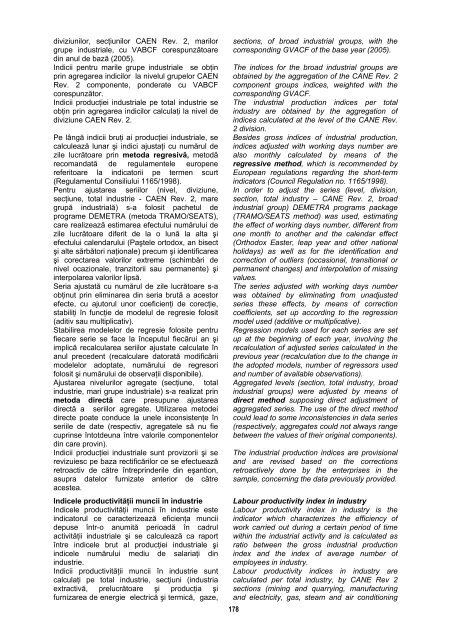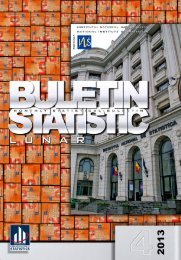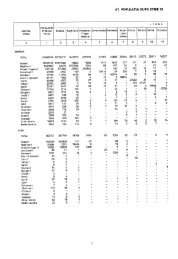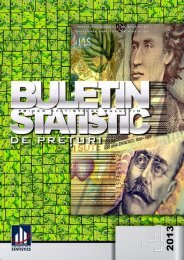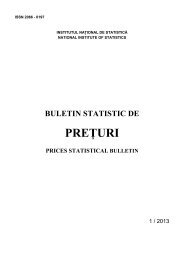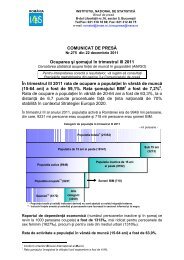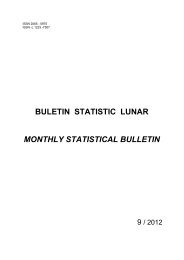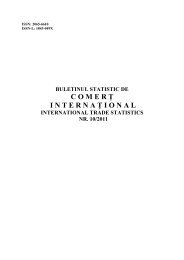BULETIN STATISTIC LUNAR MONTHLY STATISTICAL BULLETIN
BULETIN STATISTIC LUNAR MONTHLY STATISTICAL BULLETIN
BULETIN STATISTIC LUNAR MONTHLY STATISTICAL BULLETIN
You also want an ePaper? Increase the reach of your titles
YUMPU automatically turns print PDFs into web optimized ePapers that Google loves.
diviziunilor, secţiunilor CAEN Rev. 2, marilor<br />
grupe industriale, cu VABCF corespunzătoare<br />
din anul de bază (2005).<br />
Indicii pentru marile grupe industriale se obţin<br />
prin agregarea indicilor la nivelul grupelor CAEN<br />
Rev. 2 componente, ponderate cu VABCF<br />
corespunzător.<br />
Indicii producţiei industriale pe total industrie se<br />
obţin prin agregarea indicilor calculaţi la nivel de<br />
diviziune CAEN Rev. 2.<br />
Pe lângă indicii bruţi ai producţiei industriale, se<br />
calculează lunar şi indici ajustaţi cu numărul de<br />
zile lucrătoare prin metoda regresivă, metodă<br />
recomandată de regulamentele europene<br />
referitoare la indicatorii pe termen scurt<br />
(Regulamentul Consiliului 1165/1998).<br />
Pentru ajustarea seriilor (nivel, diviziune,<br />
secţiune, total industrie - CAEN Rev. 2, mare<br />
grupă industrială) s-a folosit pachetul de<br />
programe DEMETRA (metoda TRAMO/SEATS),<br />
care realizează estimarea efectului numărului de<br />
zile lucrătoare diferit de la o lună la alta şi<br />
efectului calendarului (Paştele ortodox, an bisect<br />
şi alte sărbători naţionale) precum şi identificarea<br />
şi corectarea valorilor extreme (schimbări de<br />
nivel ocazionale, tranzitorii sau permanente) şi<br />
interpolarea valorilor lipsă.<br />
Seria ajustată cu numărul de zile lucrătoare s-a<br />
obţinut prin eliminarea din seria brută a acestor<br />
efecte, cu ajutorul unor coeficienţi de corecţie,<br />
stabiliţi în funcţie de modelul de regresie folosit<br />
(aditiv sau multiplicativ).<br />
Stabilirea modelelor de regresie folosite pentru<br />
fiecare serie se face la începutul fiecărui an şi<br />
implică recalcularea seriilor ajustate calculate în<br />
anul precedent (recalculare datorată modificării<br />
modelelor adoptate, numărului de regresori<br />
folosit şi numărului de observaţii disponibile).<br />
Ajustarea nivelurilor agregate (secţiune, total<br />
industrie, mari grupe industriale) s-a realizat prin<br />
metoda directă care presupune ajustarea<br />
directă a seriilor agregate. Utilizarea metodei<br />
directe poate conduce la unele inconsistenţe în<br />
seriile de date (respectiv, agregatele să nu fie<br />
cuprinse întotdeuna între valorile componentelor<br />
din care provin).<br />
Indicii producţiei industriale sunt provizorii şi se<br />
revizuiesc pe baza rectificărilor ce se efectuează<br />
retroactiv de către întreprinderile din eşantion,<br />
asupra datelor furnizate anterior de către<br />
acestea.<br />
Indicele productivităţii muncii în industrie<br />
Indicele productivităţii muncii în industrie este<br />
indicatorul ce caracterizează eficienţa muncii<br />
depuse într-o anumită perioadă în cadrul<br />
activităţii industriale şi se calculează ca raport<br />
între indicele brut al producţiei industriale şi<br />
indicele numărului mediu de salariaţi din<br />
industrie.<br />
Indicii productivităţii muncii în industrie sunt<br />
calculaţi pe total industrie, secţiuni (industria<br />
extractivă, prelucrătoare şi producţia şi<br />
furnizarea de energie electrică şi termică, gaze,<br />
sections, of broad industrial groups, with the<br />
corresponding GVACF of the base year (2005).<br />
The indices for the broad industrial groups are<br />
obtained by the aggregation of the CANE Rev. 2<br />
component groups indices, weighted with the<br />
corresponding GVACF.<br />
The industrial production indices per total<br />
industry are obtained by the aggregation of<br />
indices calculated at the level of the CANE Rev.<br />
2 division.<br />
Besides gross indices of industrial production,<br />
indices adjusted with working days number are<br />
also monthly calculated by means of the<br />
regressive method, which is recommended by<br />
European regulations regarding the short-term<br />
indicators (Council Regulation no. 1165/1998).<br />
In order to adjust the series (level, division,<br />
section, total industry – CANE Rev. 2, broad<br />
industrial group) DEMETRA programs package<br />
(TRAMO/SEATS method) was used, estimating<br />
the effect of working days number, different from<br />
one month to another and the calendar effect<br />
(Orthodox Easter, leap year and other national<br />
holidays) as well as for the identification and<br />
correction of outliers (occasional, transitional or<br />
permanent changes) and interpolation of missing<br />
values.<br />
The series adjusted with working days number<br />
was obtained by eliminating from unadjusted<br />
series these effects, by means of correction<br />
coefficients, set up according to the regression<br />
model used (additive or multiplicative).<br />
Regression models used for each series are set<br />
up at the beginning of each year, involving the<br />
recalculation of adjusted series calculated in the<br />
previous year (recalculation due to the change in<br />
the adopted models, number of regressors used<br />
and number of available observations).<br />
Aggregated levels (section, total industry, broad<br />
industrial groups) were adjusted by means of<br />
direct method supposing direct adjustment of<br />
aggregated series. The use of the direct method<br />
could lead to some inconsistencies in data series<br />
(respectively, aggregates could not always range<br />
between the values of their original components).<br />
The industrial production indices are provisional<br />
and are revised based on the corrections<br />
retroactively done by the enterprises in the<br />
sample, concerning the data previously provided.<br />
Labour productivity index in industry<br />
Labour productivity index in industry is the<br />
indicator which characterizes the efficiency of<br />
work carried out during a certain period of time<br />
within the industrial activity and is calculated as<br />
ratio between the gross industrial production<br />
index and the index of average number of<br />
employees in industry.<br />
Labour productivity indices in industry are<br />
calculated per total industry, by CANE Rev 2<br />
sections (mining and quarrying, manufacturing<br />
and electricity, gas, steam and air conditioning<br />
178


